Malaria in North-East India: Importance and Implications in the Era of Elimination
Abstract
:1. Introduction
2. Geography of North-East (NE) States
3. Malaria Epidemiology (2008 to 2018)
4. Drug Resistance
| Year | Anti-Malarial Drug | Assay Method | State/Area | Outcome | Ref No. |
|---|---|---|---|---|---|
| 1973 | CQ | Therapeutic efficacy | Assam | RI level of resistance in 52.5% and RII level in 22.5% of cases* | [25] |
| CQ (1500 mg) | 28 days in vivo | Garohills, Meghalaya | RI-33%, RII-9.5%, RIII-12.5% | [37] | |
| 1974 | CQ | Therapeutic efficacy | Assam | RI-24% | [38] |
| Quinine + pyrimethamine | No resistance observed | ||||
| 1975 | CQ (1500 mg) | 28 days in vivo | Burnihat, Meghalaya | RI-78.3%, RII-4.3% | [37] |
| 1976 | CQ (1500 mg) | 7 days in vivo | Tezu, Lohit, AP | RI-17.9%, RII-17.9%, RIII-49.2% | |
| 1977 | CQ (900 mg) + Pyrimethamine (50 mg) | 7 days in vivo | Assam (different districts) | 0–33.4% resistance | [39] |
| CQ (600 mg) + Pyrimethamine (50 mg) | Assam (different districts) | 0–90.0% resistance | |||
| CQ (600 mg) + Pyrimethamine (45 mg) | Karbi Anglong, Assam | 46% resistance | |||
| CQ (600 mg) + Pyrimethamine (50 mg) | Nagaland | 51.2% resistance | [40] | ||
| CQ (900 mg) + Pyrimethamine (50 mg) | 22% resistance | ||||
| CQ (600 mg) + Pyrimethamine (45 mg) | 47% resistance | ||||
| CQ (1500 mg) | Bama Bazar, Garohills, Meghalaya | S/RI-82.2%, RIII-18% | [37] | ||
| CQ (600 mg) + Pyrimethamine (50 mg) | Miao, AP | 29.9% resistance | [41] | ||
| CQ (600 mg) + Pyrimethamine (50 mg) | North Tripura | No resistance observed | |||
| CQ (600 mg) + Pyrimethamine (50 mg) | Aizawl, Mizoram | 29% resistance | |||
| CQ (600 mg) + Pyrimethamine (50 mg) | Jiribam, Manipur | No resistance observed | |||
| 1978 | CQ (1500 mg) | 7 days in vivo | Karbi Anglong, Assam | 66.6% resistance | [39] |
| 1979 | CQ (1500 mg) | 28 days in vivo | Mendipathar, Garohills, Meghalaya | RI-50% | [37] |
| 1995 | CQ | 3 days in vivo test | Assam | S/RI-85%, RI-7%, RII-3%, RIII-5% | [42] |
| Alpha-Beta Arteether | 28 days therapeutic efficacy | Dibrugarh, Assam | No resistance observed | [43] | |
| 1999 | CQ | 28 days in vivo | Jairampur, AP (Indo-Myanmar Border) | ETF-60.4%, LTF-22.6% | [44] |
| SP | do | do | ETF-32.6%, LTF-11.6% | ||
| quinine | 7 days in vivo | do | 15.8% treatment failure observed | ||
| 2001 | CQ | 42 days prospective randomized non-blinded trial | Bokajan, Karbi Anglong, Assam | RI-53%, RII-2.2%, RIII-8.9% | [45] |
| SP | Sonitpur, Assam | RI-29%, RII-3.8%, RIII-5.8% | |||
| Mefloquine | RI-4.4% | ||||
| Mefloquine+artesunate | RI-8.7%, RIII-2% | ||||
| CQ | RI-37.5%, RII-29%, RIII-29% | ||||
| SP | RI-36.7%, RII-14.3%, RIII-6.1% | ||||
| Mefloquine | RI-5.9%, RII-2% | ||||
| Mefloquine+artesunate | RI-1.9% | ||||
| 2002–2003 | CQ | 28 days in vivo | AP | ETF-23.8%, LCF-14.3%, LPF-10.7% | [46] |
| SP | AP | ETF-14.1%, LCF-12.6%, LPF-8.1% | |||
| 2005 | CQ | 35 days in vivo | Assam | RI-13%, RII-4%, RIII-Nil | [47] |
| SP | No resistance | ||||
| 2007–2010 | CQ | Molecular (Nested PCR) | Sonitpur, Assam | pfcrt K76T-72.13%, pfmdr1 N86Y-41.79%, K76T + N86Y-32.7% | [48] |
| 2010 | CQ | In vivo therapeutic efficacy | Tripura (Indo-Bangladesh Border) | ~30% ETF, 5% LTF | [49] |
| 2011 | CQ | 28 days in vivo | Tripura | ETF-32.5%, LCF-35%, | [50] |
5. Vectors of NE India
6. Role of Secondary Vectors
| Species | Sibling Species Present | Range | Bionomical Characteristics | Disease Transmission Relationships | |||||
|---|---|---|---|---|---|---|---|---|---|
| Larval Habitat | Resting Habitat | Feeding Habit | Peak Biting Activity (hours) | Susceptibility Status to Insecticides | Density | Infectivity | |||
| An. dirus complex | An. baimaii (Dirus D) [8,9] | All NE Indian states except for Sikkim [9] | Water pits, elephant footprints, rock bed ravine, mud pools etc. | Outdoor | Highly anthropophillic, both indoor and outdoor biter [72] | 21:00–03:00 | Susceptible [83] | 5.78# (1986–1988, Arunachal Pradesh) [84]; 0.39* (1989–1990, Assam) [66]; 5.03* (2000–2001, Assam) [85]; 1.54# (2007–2008, Tripura) [49]; 4.0–6.0* (2012, Tripura) [83]; 4.0* (2014, Tripura) [86] | 0.97% (1986–1988, Arunachal Pradesh) [84]; 1.6% (Aug1995-July1996, Assam) [87]; 3.2% (June 1999 to May 2000, Assam) [88]; 0.7% sporozoite rate (2000, Assam) [85]; 1.9% (1995–2000, Assam) [71]; 11% (2014, Tripura) [86] |
| An. minimus complex | An. minimus (Sibling Sp. A) [8] | All NE Indian states except for Sikkim | Perennial foothill seepage water streams | Human-dwellings indoors | Highly anthropophillic | 01:00-04:00 | Susceptible [83] | 1.86# (1986–1988, Arunachal Pradesh) [84]; 0.4* (2014, Tripura) [86] | 0.40% (1986–1988, Arunachal Pradesh) [84] 0.05% (2012, Tripura) [83]. |
| Sl. No. | Year of Incrimination | Month/Season | Place | Species | Total Positivity | Method of Incrimination | Reference |
|---|---|---|---|---|---|---|---|
| 1 | 1941 | Not Known | Assam | An. culicifacies | 0.56% | Dissection | [78] |
| 2 | 1968 | August | Burnihat, Meghalaya | An. phillipinensis | 1 no | Dissection | [79] |
| 3 | 1969 | July | Burnihat, Meghalaya | 1 no | Dissection | ||
| 4 | 2001–2002 | Throughout the year | Jorhat, Assam | An. aconitus | 3.95% | CSP ELISA | [77] |
| An. annularis | 5.80% | ||||||
| An. hyrcanus gp | 0.48% | ||||||
| An. jeyporiensis | 6.25% | ||||||
| An. kochi | 1.28% | ||||||
| An. phillipinensis/nivipes | 0.94% | ||||||
| An. tesellatus | 6.67% | ||||||
| An. varuna | 3.23% | ||||||
| An. vagus | 3.87% | ||||||
| 5 | 2000–2002 | Throughout the year | Jairampur, AP | An. Phillipinensis/nivipes | 1.20% | CSP ELISA | [89] |
| Soraipung, DBR, Assam | 2.60% | ||||||
| Titabor, Assam | 1.70% | ||||||
| 6 | 2008–2009 | April-October | Jorhat, Assam | An. nivipes | 0.70% | PCR | [10] |
| Dimapur, Nagaland | 0.95% | ||||||
| 7 | 2012 | Pre & Post monsoon | Assam | An. culicifacies | 2.50% | CSP ELISA | [90] |
| Meghalaya | 3.50% | ||||||
| Manipur | 1.20% | ||||||
| 2013 | Assam | 10.90% | |||||
| Meghalaya | 6.40% | ||||||
| Manipur | 1.80% | ||||||
| 2014 | Assam | 6.60% | |||||
| Meghalaya | 3.50% | ||||||
| Manipur | 9.50% | ||||||
| 8 | 2013 | March-August | Orang, Assam | An. vagus | 0.56* | CSP-ICT | [91] |
| Orang, Assam | An. annularis | 0.22* | |||||
| Balipara, Assam | An. vagus | 0.13* |
7. Conclusions and Future Directions
Author Contributions
Funding
Acknowledgments
Conflicts of Interest
Appendix A
References
- WHO. World malaria report; World Health Organization: Geneva, Switzerland, 2018. [Google Scholar]
- Available online: https://www.nvbdcp.gov.in/WriteReadData/l892s/95838975781568980798.pdf (accessed on 24 September 2019).
- Wangdi, K.; Gatton, M.L.; Kelly, G.C.; Banwell, C.; Dev, V.; Clements, A.C.A. Malaria elimination in India and regional implications. Lancet Infect. Dis. 2016, 16, e214–e224. [Google Scholar] [CrossRef]
- Available online: https://www.who.int/malaria/publications/country-profiles/profile_ind_en.pdf?ua=1 (accessed on 24 September 2019).
- Dev, V.; Bhattacharyya, P.C.; Talukdar, R. Transmission of malaria and its control in the northeastern region of India. J. Assoc. Physicians India 2003, 51, 1073–1076. [Google Scholar] [PubMed]
- Mohapatra, P.K.; Prakash, A.; Bhattacharyya, D.R.; Goswami, B.K.; Ahmed, A.; Sarmah, B.; Mahanta, J. Detection & molecular confirmation of a focus of Plasmodium malariae in Arunachal Pradesh, India. Indian J. Med. Res. 2008, 128, 52–56. [Google Scholar] [PubMed]
- Prakash, A.; Mohapatra, P.; Bhattacharyya, D.; Goswami, B.K.; Mahanta, J. Plasmodium ovale: First case report from Assam, India. Curr. Sci. 2003, 84, 1187–1188. [Google Scholar]
- Prakash, A.; Walton, C.; Bhattacharyya, D.R.; Loughlin, S.O.; Mohapatra, P.K.; Mahanta, J. Molecular characterization and species identification of the Anopheles dirus and An. minimus complexes in north-east India using r-DNA ITS-2. Acta Trop. 2006, 100, 156–161. [Google Scholar] [CrossRef]
- Prakash, A.; Sarma, D.K.; Bhattacharyya, D.R.; Mohapatra, P.K.; Bhattacharjee, K.; Das, K.; Mahanta, J. Spatial distribution and r-DNA second internal transcribed spacer characterization of Anopheles dirus (Diptera: Culicidae) complex species in north-east India. Acta Trop. 2010, 114, 49–54. [Google Scholar] [CrossRef]
- Bhattacharyya, D.R.; Prakash, A.; Sarma, N.P.; Mohapatra, P.K.; Singh, S.; Sarma, D.K.; Kalita, M.C.; Mahanta, J. Molecular evidence for the involvement of Anopheles nivipes (Diptera: Culicidae) in the transmission of Plasmodium falciparum in north-eastern India. Ann. Trop. Med. Parasitol. 2010, 104, 331–336. [Google Scholar] [CrossRef]
- Mohapatra, P.K.; Sarma, D.K.; Prakash, A.; Bora, K.; Ahmed, M.A.; Sarma, B.; Goswami, B.K.; Bhattacharyya, D.R.; Mahanta, J. Molecular evidence of increased resistance to anti-folate drugs in Plasmodium falciparum in North-East India: A signal for potential failure of artemisinin plus sulphadoxine-pyrimethamine combination therapy. PLoS ONE 2014, 9, e105562. [Google Scholar] [CrossRef] [Green Version]
- Mishra, N.; Kaitholia, K.; Srivastava, B.; Shah, N.K.; Narayan, J.P.; Dev, V.; Phookan, S.; Anvikar, A.R.; Rana, R.; Bharti, R.S.; et al. Declining efficacy of artesunate plus sulphadoxine-pyrimethamine in northeastern India. Malar. J. 2014, 13, 284. [Google Scholar] [CrossRef] [Green Version]
- WHO-SEARO. India Launches the National Framework to Eliminate Malaria; World Health Organization: Geneva, Switzerland, 2016. [Google Scholar]
- Ghosh, S.K.; Rahi, M. Malaria elimination in India-The way forward. J. Vector Borne Dis. 2019, 56, 32–40. [Google Scholar] [CrossRef]
- WHO. World Malaria Report; World Health Organization: Geneva, Switzerland, 2015. [Google Scholar]
- APMEN. Elimination 2030. Asia Pacific malaria elimination network. 2015. Available online: https://www.apmen.org/web/1/elimination/ (accessed on 24 September 2019).
- Dikshit, K.R.; Dikshit, J.K. Relief Features of North-East India. In North-East India: Land, People and Economy; Dikshit, K.R., Dikshit, J.K., Eds.; Springer Netherlands: Dordrecht, The Netherlands, 2014; pp. 91–125. [Google Scholar]
- Dikshit, K.R.; Dikshit, J.K. Weather and Climate of North-East India. In North-East India: Land, People and Economy; Springer: Dordrecht, The Netherlands, 2014; pp. 149–173. [Google Scholar]
- Dikshit, K.R.; Dikshit, J.K. Natural Vegetation: Forests and Grasslands of North-East India. In North-East India: Land, People and Economy; Springer: Dordrecht, The Netherlands, 2014; pp. 213–255. [Google Scholar]
- Dikshit, K.R.; Dikshit, J.K. Population of the North-Eastern States of India. In North-East India: Land, People and Economy; Springer: Dordrecht, The Netherlands, 2014; pp. 421–456. [Google Scholar]
- Mohapatra, P.K.; Prakash, A.; Bhattacharyya, D.R.; Mahanta, J. Malaria situation in north-eastern region of India. Icmr Bull. 1998, 28, 21–30. [Google Scholar]
- Sharma, V.P.; Dev, V.; Phookan, S. Neglected Plasmodium vivax malaria in northeastern States of India. Indian J. Med. Res. 2015, 141, 546–555. [Google Scholar] [PubMed]
- Fairhurst, R.M.; Dondorp, A.M. Artemisinin-Resistant Plasmodium falciparum Malaria. Microbiol. Spectr. 2016, 4, 3. [Google Scholar] [CrossRef] [PubMed] [Green Version]
- Payne, D. Spread of chloroquine resistance in Plasmodium falciparum. Parasitol. Today 1987, 3, 241–246. [Google Scholar] [CrossRef]
- Sehgal, P.N.; Sharma, M.I.D.; Sharma, S.L.; Gogai, S. Resistance to chloroquine in falciparum malaria in Assam State, India. J. Commun. Dis. 1973, 5, 175–180. [Google Scholar]
- Shah, N.K.; Dhillon, G.P.; Dash, A.P.; Arora, U.; Meshnick, S.R.; Valecha, N. Antimalarial drug resistance of Plasmodium falciparum in India: Changes over time and space. Lancet Infect. Dis. 2011, 11, 57–64. [Google Scholar] [CrossRef] [Green Version]
- Available online: https://nvbdcp.gov.in/Doc/drug-policy-2010.pdf (accessed on 24 September 2019).
- Mishra, N.; Singh, J.P.; Srivastava, B.; Arora, U.; Shah, N.K.; Ghosh, S.K.; Bhatt, R.M.; Sharma, S.K.; Das, M.K.; Kumar, A.; et al. Monitoring antimalarial drug resistance in India via sentinel sites: Outcomes and risk factors for treatment failure, 2009–2010. Bull. World Health Organ. 2012, 90, 895–904. [Google Scholar] [CrossRef]
- Das, S.B.B.; Roy, J.R.; Guha, A.K.; Rastogi, A.C. Pyrimethamine in combination with sulfadoxine or sulfalene in P. falciparum infected cases in India. Indian J. Malariol. 1981, 18, 109–116. [Google Scholar]
- Ariey, F.; Witkowski, B.; Amaratunga, C.; Beghain, J.; Langlois, A.C.; Khim, N.; Kim, S.; Duru, V.; Bouchier, C.; Ma, L.; et al. A molecular marker of artemisinin-resistant Plasmodium falciparum malaria. Nature 2014, 505, 50–55. [Google Scholar] [CrossRef]
- Mishra, N.; Bharti, R.S.; Mallick, P.; Singh, O.P.; Srivastava, B.; Rana, R.; Phookan, S.; Gupta, H.P.; Ringwald, P.; Valecha, N. Emerging polymorphisms in falciparum Kelch 13 gene in Northeastern region of India. Malar. J. 2016, 15, 583. [Google Scholar] [CrossRef] [Green Version]
- Mishra, N.; Prajapati, S.K.; Kaitholia, K.; Bharti, R.S.; Srivastava, B.; Phookan, S.; Anvikar, A.R.; Dev, V.; Sonal, G.S.; Dhariwal, A.C.; et al. Surveillance of artemisinin resistance in Plasmodium falciparum in India using the kelch13 molecular marker. Antimicrob. Agents Chemother. 2015, 59, 2548–2553. [Google Scholar] [CrossRef] [PubMed] [Green Version]
- Mishra, S.; Bharti, P.K.; Shukla, M.M.; Ali, N.A.; Kashyotia, S.S.; Kumar, A.; Dhariwal, A.C.; Singh, N. Clinical and molecular monitoring of Plasmodium falciparum resistance to antimalarial drug (artesunate+sulphadoxine-pyrimethamine) in two highly malarious district of Madhya Pradesh, Central India from 2012–2014. Pathog. Glob. Health 2017, 111, 186–194. [Google Scholar] [CrossRef] [PubMed]
- Chakrabarti, R.; White, J.; Babar, P.H.; Kumar, S.; Mudeppa, D.G.; Mascarenhas, A.; Pereira, L.; Dash, R.; Maki, J.N.; Sharma, A.; et al. Decreased in vitro artemisinin sensitivity of Plasmodium falciparum across India. Antimicrob. Agents Chemother. 2019. [Google Scholar] [CrossRef] [PubMed] [Green Version]
- Das, S.; Manna, S.; Saha, B.; Hati, A.K.; Roy, S. Novel pfkelch13 Gene Polymorphism Associates With Artemisinin Resistance in Eastern India. Clin. Infect. Dis. Off. Publ. Infect. Dis. Soc. Am. 2019, 69, 1144–1152. [Google Scholar] [CrossRef] [PubMed] [Green Version]
- Anvikar, A. Guidelines for Diagnosis and Treatment of Malaria in India, 2nd ed.; National Institute of Malaria Research: New Delhi, India, 2011. [Google Scholar]
- Chakravarty, S.C.; Dwivedi, S.R.; Das, S.; Pukan, D.; Roy, R.G.; Pattanayak, S. Response of Plasmodium falciparum to chloroquine in the Meghalaya state. Indian J. Med. Res. 1979, 70, 34–39. [Google Scholar] [PubMed]
- Sehgal, P.N.; Sharma, S.S. Efficacy of quinine with pyrimethamine against chloroquine resistant P. falciparum malaria in Assam State India. J. Commun. Dis. 1974, 6, 175–180. [Google Scholar]
- Pattanayak, S.; Roy, R.G.; Phukan, D.; Barkakuty, B.N. Chloroquine resistance in P. falciparum in Assam State. Indian J. Med. Res. 1979, 70, 14–19. [Google Scholar]
- Das, S.; Roy, R.G.; Pattanayak, S. A note on chloroquine resistance tests on P. falciparum in Nagaland. Indian J. Med. Res. 1979, 70, 30–33. [Google Scholar]
- Pattanayak, S.; Roy, R.G.; Sen, N. Response of Chloroquine with or without pyrimethamine in Plasmodium falciparum in West Bengal, Tripura, Mizoram, Manipur and Arunachal Pradesh. Indian J. Med. Res. 1979, 70, 48–51. [Google Scholar]
- Gogoi, S.C.; Dev, V.; Choudhury, B.; Phookan, S. Susceptibility of Plasmodium falciparum to chloroquine in tea garden tribes of Assam, India. Southeast Asian J. Trop. Med. Public Health 1995, 26, 228–230. [Google Scholar]
- Mohapatra, P.K.; Khan, A.M.; Prakash, A.; Mahanta, J.; Srivastava, V.K. Effect of arteether alpha/beta on uncomplicated falciparum malaria cases in Upper Assam. Indian J. Med. Res. 1996, 104, 284–287. [Google Scholar] [PubMed]
- Mohapatra, P.K.; Namchoom, N.S.; Prakash, A.; Bhattacharya, D.R.; Goswami, B.K.; Mahanta, J. Therapeutic efficacy of anti-malarials in Plasmodium falciparum malaria in an Indo-Myanmar border area of Arunachal Pradesh. Indian J. Med. Res. 2003, 118, 71–76. [Google Scholar] [PubMed]
- Campbell, P.; Baruah, S.; Narain, K.; Rogers, C.C. A randomized trial comparing the efficacy of four treatment regimens for uncomplicated falciparum malaria in Assam state, India. Trans. R. Soc. Trop. Med. Hyg. 2006, 100, 108–118. [Google Scholar] [CrossRef] [PubMed] [Green Version]
- Mohapatra, P.K.; Prakash, A.; Taison, K.; Negmu, K.; Gohain, A.C.; Namchoom, N.S.; Wange, D.; Bhattacharyya, D.R.; Goswami, B.K.; Borgohain, B.K.; et al. Evaluation of chloroquine (CQ) and sulphadoxine/pyrimethamine (SP) therapy in uncomplicated falciparum malaria in Indo-Myanmar border areas. Trop. Med. Int. Health 2005, 10, 478–483. [Google Scholar] [CrossRef] [PubMed]
- Baruah, I.; Talukdar, P.K.; Das, S.C. The drug sensitivities of Plasmodium falciparum in the Sonitpur district, Assam, India. Southeast Asian J. Trop. Med. Public Health 2005, 36, 587–590. [Google Scholar]
- Goswami, D.; Dhiman, S.; Rabha, B.; Kumar, D.; Baruah, I.; Veer, V.; Bhola, R.; Sharma, D. High prevalence of pfcrt K76T and mdr1 N86Y mutations in Sonitpur district of Assam, India. J. Parasit. Dis. Off. Organ Indian Soc. Parasitol. 2014, 38, 250–254. [Google Scholar] [CrossRef] [Green Version]
- Dhiman, S.; Goswami, D.; Rabha, B.; Gopalakrishnan, R.; Baruah, I.; Singh, L. Malaria epidemiology along Indo-Bangladesh border in Tripura State, India. Southeast Asian J. Trop. Med. Public Health 2010, 41, 1279–1289. [Google Scholar]
- Majumdar, T.D.N.; Roy, D.B. Assessment of therapeutic efficacy of chloroquine in uncomplicated Plasmodium falciparum malaria in a rural area of Tripura. J. Pharm. Biomed. Sci. 2011, 10, 1–7. [Google Scholar]
- Nagpal, B.N.; Sharma, V.P. Indian anophelines; Science Publishers: Lebanon, NH, USA, 1995. [Google Scholar]
- Bhattacharyya, D.; Rajavel, A.; Natarajan, R.; Mohapatra, P.; Jambulingam, P.; Mahanta, J.; Prakash, A. Faunal richness and the checklist of Indian mosquitoes (Diptera: Culicidae). Check List 2014, 10, 1342–1358. [Google Scholar] [CrossRef] [Green Version]
- Lal, S.; Sonal, G.S.; Phukar, P.K. Status of malaria in India. J. Indian Acad. Clin. Med. 2000, 5, 19–23. [Google Scholar]
- Sharma, V.P. Current scenario of malaria in India. Parassitologia 1999, 41, 349–353. [Google Scholar] [PubMed]
- Myers, N.; Mittermeier, R.A.; Mittermeier, C.G.; da Fonseca, G.A.; Kent, J. Biodiversity hotspots for conservation priorities. Nature 2000, 403, 853–858. [Google Scholar] [CrossRef] [PubMed]
- Malhotra, P.R.; Mahanta, H.C. Check-List of mosquitoes of Northeast India (Diptera: Culicidae). Orient. Insects 1994, 28, 125–149. [Google Scholar] [CrossRef]
- Harbach, R.E.; Parkin, E.; Chen, B.; Butlin, R.K. Anopheles (Cellia) minimus Theobald (Diptera: Culicidae): Neotype designation, characterization, and systematics. Proc. Entomol. Soc. Wash. 2006, 108, 198–209. [Google Scholar]
- Harbach, R.E.; Garros, C.; Manh, N.D.; Manguin, S. Formal taxonomy of species C of the Anopheles minimus sibling species complex (Diptera: Culicidae). Zootaxa 2007, 1654, 41–54. [Google Scholar] [CrossRef]
- Chen, B.; Harbach, R.E.; Butlin, R.K. Molecular and morphological studies on the Anopheles minimus group of mosquitoes in southern China: Taxonomic review, distribution and malaria vector status. Med. Vet. Entomol. 2002, 16, 253–265. [Google Scholar] [CrossRef]
- Somboon, P.; Rory, A.; Tsuda, Y.; Takagi, M.; Harbach, R. Systematics of Anopheles (Cellia) yaeyamaensis sp. n. alias species E of the An. minimus complex in southeastern Asia (Diptera: Culicidae). Zootaxa 2010, 2651, 43–51. [Google Scholar] [CrossRef]
- Kareem, M.A.; Singh, Y.K.; Bhatnagar, V.N.; Krishnamurthy, B.S.; Das, M.; Sharma, G.K. A preliminary report on some entomological observations in malaria endemic areas of Kamrup district, Assam. J. Commun. Dis. 1985, 17, 29–35. [Google Scholar]
- Prakash, A.; Mohapatra, P.K.; Srivastava, V.K. Vector incrimination in Tamulpur primary health centre, district Nalbari, lower Assam during malaria outbreak 1995. Indian J. Med. Res. 1996, 103, 146–149. [Google Scholar]
- Dutta, P.; Baruah, B.D. Incrimination of Anopheles minimus Theobald as a vector of malaria in Arunachal Pradesh. Indian J. Malariol. 1987, 24, 159–162. [Google Scholar]
- Bhatnagar, V.N.; Dwivedi, S.R.; Mishra, B.G.; Das, M. Detection and incrimination of Anopheles minimus Theobald 1901 as malaria vector in the foothill areas of Nagaland, India. Indian J. Malariol. 1982, 19, 129–133. [Google Scholar]
- Das, S.C.; Baruah, I. Incrimination of Anopheles minimus Theobald and Anopheles balabacensis balabacensis Baisas (A. dirus) as malaria vectors in Mizoram. Indian J. Malariol. 1985, 22, 53–55. [Google Scholar] [PubMed]
- Dev, V. Anopheles minimus: Its bionomics and role in the transmission of malaria in Assam, India. Bull. World Health Organ. 1996, 74, 61–66. [Google Scholar] [PubMed]
- Prakash, A.; Bhattacharya, D.R.; Mohapatra, P.K.; Mahanta, J. Insecticide susceptibility of Anopheles dirus in Assam. J. Commun. Dis. 1998, 30, 291–292. [Google Scholar]
- Dev, V.; Manguin, S. Biology, distribution and control of Anopheles (Cellia) minimus in the context of malaria transmission in northeastern India. Parasites Vectors 2016, 9, 585. [Google Scholar] [CrossRef] [Green Version]
- Garros, C.; Harbach, R.E.; Manguin, S. Systematics and biogeographical implications of the phylogenetic relationships between members of the funestus and minimus groups of Anopheles (Diptera: Culicidae). J. Med. Entomol. 2005, 42, 7–18. [Google Scholar] [CrossRef]
- Singh, O.P.; Nanda, N.; Dev, V.; Bali, P.; Sohail, M.; Mehrunnisa, A.; Adak, T.; Dash, A.P. Molecular evidence of misidentification of Anopheles minimus as Anopheles fluviatilis in Assam (India). Acta Trop. 2010, 113, 241–244. [Google Scholar] [CrossRef]
- Prakash, A.; Bhattacharyya, D.R.; Mohapatra, P.K.; Mahanta, J. Malaria transmission risk by the mosquito Anopheles baimaii (formerly known as An. dirus species D) at different hours of the night in North-east India. Med. Vet. Entomol. 2005, 19, 423–427. [Google Scholar] [CrossRef]
- Dutta, P.; Bhattacharyya, D.R.; Khan, S.A.; Sharma, C.K.; Mahanta, J. Feeding patterns of Anopheles dirus, the major vector of forest malaria in north east India. Southeast Asian J. Trop. Med. Public Health 1996, 27, 378–381. [Google Scholar]
- Dutta, P.; Bhattacharyya, D.R.; Sharma, C.K.; Dutta, L.P. The importance of Anopheles dirus (A. balabacensis) as a vector of malaria in northeast India. Indian J. Malariol. 1989, 26, 95–101. [Google Scholar]
- Gould, D.J.; Cadigan, F.C.; Ward, R.A. Falciparum malaria: Transmission to the gibbon by Anopheles balabacensis. Science 1966, 153, 1384. [Google Scholar] [CrossRef] [PubMed]
- Yang, T.H. A review of literature on Anopheles balabacensis balabacensis; WHO/MAL/83.999, WHO/MAL/83.878.30; World Health Organization: Geneva, Switzerland, 1983. [Google Scholar]
- Sarma, D.K.; Prakash, A.; O’Loughlin, S.M.; Bhattacharyya, D.R.; Mohapatra, P.K.; Bhattacharjee, K.; Das, K.; Singh, S.; Sarma, N.P.; Ahmed, G.U.; et al. Genetic population structure of the malaria vector Anopheles baimaii in north-east India using mitochondrial DNA. Malar. J. 2012, 11, 76. [Google Scholar] [CrossRef] [PubMed] [Green Version]
- Prakash, A.; Bhattacharyya, D.R.; Mohapatra, P.K.; Mahanta, J. Role of the prevalent Anopheles species in the transmission of Plasmodium falciparum and P. vivax in Assam state, north-eastern India. Ann. Trop. Med. Parasitol. 2004, 98, 559–568. [Google Scholar] [CrossRef] [PubMed]
- Anderson, L.A.P.; Viswanathan, D.K. The Assam Medical Research Society, Shillong: A resume on its activities during 1931–1941. Calcatta:ThackerSpink Co. 1943. Available online: https://www.cabdirect.org/cabdirect/abstract/19431000207 (accessed on 24 September 2019).
- Rajagopal, R. Studies on persistent transmission of malaria in Burnihat, Meghalaya. J. Commun. Dis. 1976, 8, 235–245. [Google Scholar]
- Dev, V.; Sharma, V. The Dominant Mosquito Vectors of Human Malaria in India, Anopheles mosquitoes-New insights into malaria vectors, Sylvie Manguin. In Anopheles Mosquitoes, New Insights Into Malaria Vectors; Manguin, S., Ed.; IntechOpen: Rijeka, Croatia, 2013; Available online: https://www.intechopen.com/books/anopheles-mosquitoes-new-insights-into-malaria-vectors/the-dominant-mosquito-vectors-of-human-malaria-in-india (accessed on 24 September 2019).
- Dhiman, S.; Rabha, B.; Goswami, D.; Das, N.G.; Baruah, I.; Bhola, R.K.; Veer, V. Insecticide resistance and human blood meal preference of Anopheles annularis in Asom-Meghalaya border area, northeast India. J. Vector Borne Dis. 2014, 51, 133–136. [Google Scholar] [PubMed]
- Raghavendra, K.; Velamuri, P.S.; Verma, V.; Elamathi, N.; Barik, T.K.; Bhatt, R.M.; Dash, A.P. Temporo-spatial distribution of insecticide-resistance in Indian malaria vectors in the last quarter-century: Need for regular resistance monitoring and management. J. Vector Borne Dis. 2017, 54, 111–130. [Google Scholar] [PubMed]
- Dev, V.; Adak, T.; Singh, O.P.; Nanda, N.; Baidya, B.K. Malaria transmission in Tripura: Disease distribution & determinants. Indian J. Med. Res. 2015, 142, S12–S22. [Google Scholar]
- Dutta, P.; Bhattacharyya, D.R.; Sharma, C.K.; Dutta, L.P. Anopheline fauna of parts of Tirap district, Arunachal Pradesh with reference to malaria transmission. Indian J. Med. Res. 1992, 95, 245–249. [Google Scholar]
- Prakash, A.; Bhattacharyya, D.R.; Mohapatra, P.K.; Barua, U.; Phukan, A.; Mahanta, J. Malaria control in a forest camp in an oil exploration area of Upper Assam. Natl. Med. J. India 2003, 16, 135–138. [Google Scholar]
- Sarmah, N.; Bhowmik, I.; Sarma, D.; Sharma, C.; Medhi, G.; Mohapatra, P.; Mahanta, J.; Bhattacharyya, D. Role of Anopheles baimaii: Potential vector of epidemic outbreak in Tripura, North-east India. J. Glob. Health Rep. 2019, 3. [Google Scholar] [CrossRef]
- Prakash, A.; Bhattacharyya, D.R.; Mohapatra, P.K.; Mahanta, J. Seasonal prevalence of Anopheles dirus and malaria transmission in a forest fringed village of Assam, India. Indian J. Malariol. 1997, 34, 117–125. [Google Scholar] [PubMed]
- Prakash, A.; Bhattacharyya, D.R.; Mohapatra, P.K.; Mahanta, J. Estimation of vectorial capacity of Anopheles dirus (Diptera: Culicidae) in a forest-fringed village of Assam (India). Vector Borne Zoonotic Dis. 2001, 1, 231–237. [Google Scholar] [CrossRef] [PubMed]
- Prakash, A.; Bhattacharyya, D.R.; Mohapatra, P.K.; Mahanta, J. Potential of Anopheles philippinensis-nivipes complex mosquitoes as malaria vector in north-east India. J. Environ. Biol. 2005, 26, 719–723. [Google Scholar] [PubMed]
- Akhtar, N.; Nagpal, B.N.; Kapoor, N.; Srivastava, A.; Valecha, N. Role of An. culicifacies as a vector of malaria in changing ecological scenario of Northeastern states of India. J. Vector Borne Dis. 2016, 53, 264–271. [Google Scholar] [PubMed]
- Dhiman, S.; Yadav, K.; Rabha, B.; Goswami, D.; Hazarika, S.; Tyagi, V. Evaluation of Insecticides Susceptibility and Malaria Vector Potential of Anopheles annularis s.l. and Anopheles vagus in Assam, India. PLoS ONE 2016, 11, e0151786. [Google Scholar] [CrossRef] [PubMed]
- Lindblade, K.A.; Steinhardt, L.; Samuels, A.; Kachur, S.P.; Slutsker, L. The silent threat: Asymptomatic parasitemia and malaria transmission. Expert Rev. Anti-Infect. Ther. 2013, 11, 623–639. [Google Scholar] [CrossRef] [Green Version]
- Sattabongkot, J.; Suansomjit, C.; Nguitragool, W.; Sirichaisinthop, J.; Warit, S.; Tiensuwan, M.; Buates, S. Prevalence of asymptomatic Plasmodium infections with sub-microscopic parasite densities in the northwestern border of Thailand: A potential threat to malaria elimination. Malar. J. 2018, 17, 329. [Google Scholar] [CrossRef] [Green Version]
- Poirot, E.; Skarbinski, J.; Sinclair, D.; Kachur, S.P.; Slutsker, L.; Hwang, J. Mass drug administration for malaria. Cochrane Database Syst. Rev. 2013, 12, CD008846. Available online: https://pubmed.ncbi.nlm.nih.gov/24318836-mass-drug-administration-for-malaria (accessed on 24 September 2019). [CrossRef]
- Kumar, A.; Hosmani, R.; Jadhav, S.; de Sousa, T.; Mohanty, A.; Naik, M.; Shettigar, A.; Kale, S.; Valecha, N.; Chery, L.; et al. Anopheles subpictus carry human malaria parasites in an urban area of Western India and may facilitate perennial malaria transmission. Malar. J. 2016, 15, 124. [Google Scholar] [CrossRef] [Green Version]
- Zomuanpuii, R.; Ringngheti, L.; Brindha, S.; Gurusubramanian, G.; Senthil Kumar, N. ITS2 characterization and Anopheles species identification of the subgenus Cellia. Acta Trop. 2013, 125, 309–319. [Google Scholar] [CrossRef]
- Rieckmann, K.H. Monitoring the response of malaria infections to treatment. Bull. World Health Organ. 1990, 68, 759–760. [Google Scholar] [PubMed]
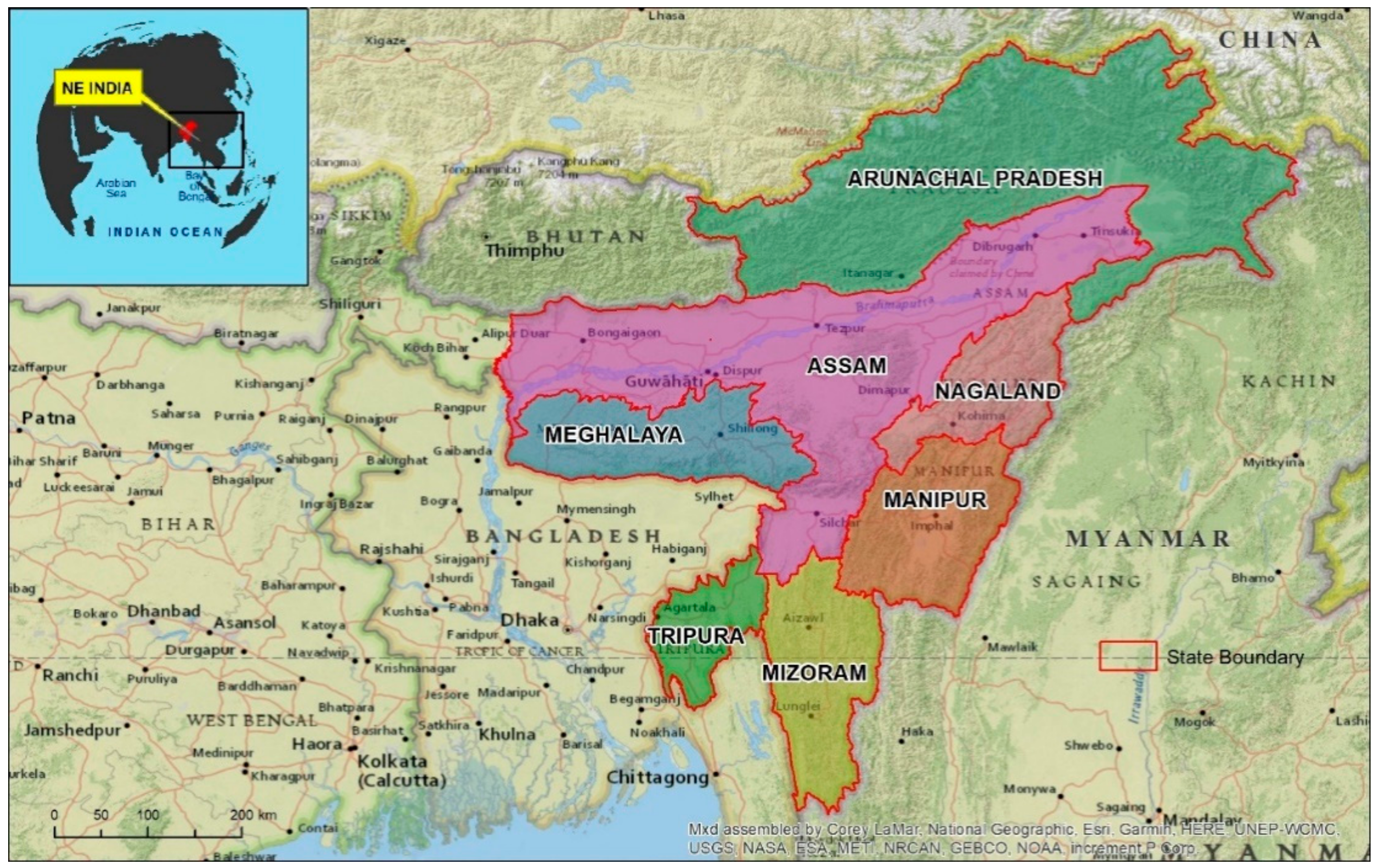
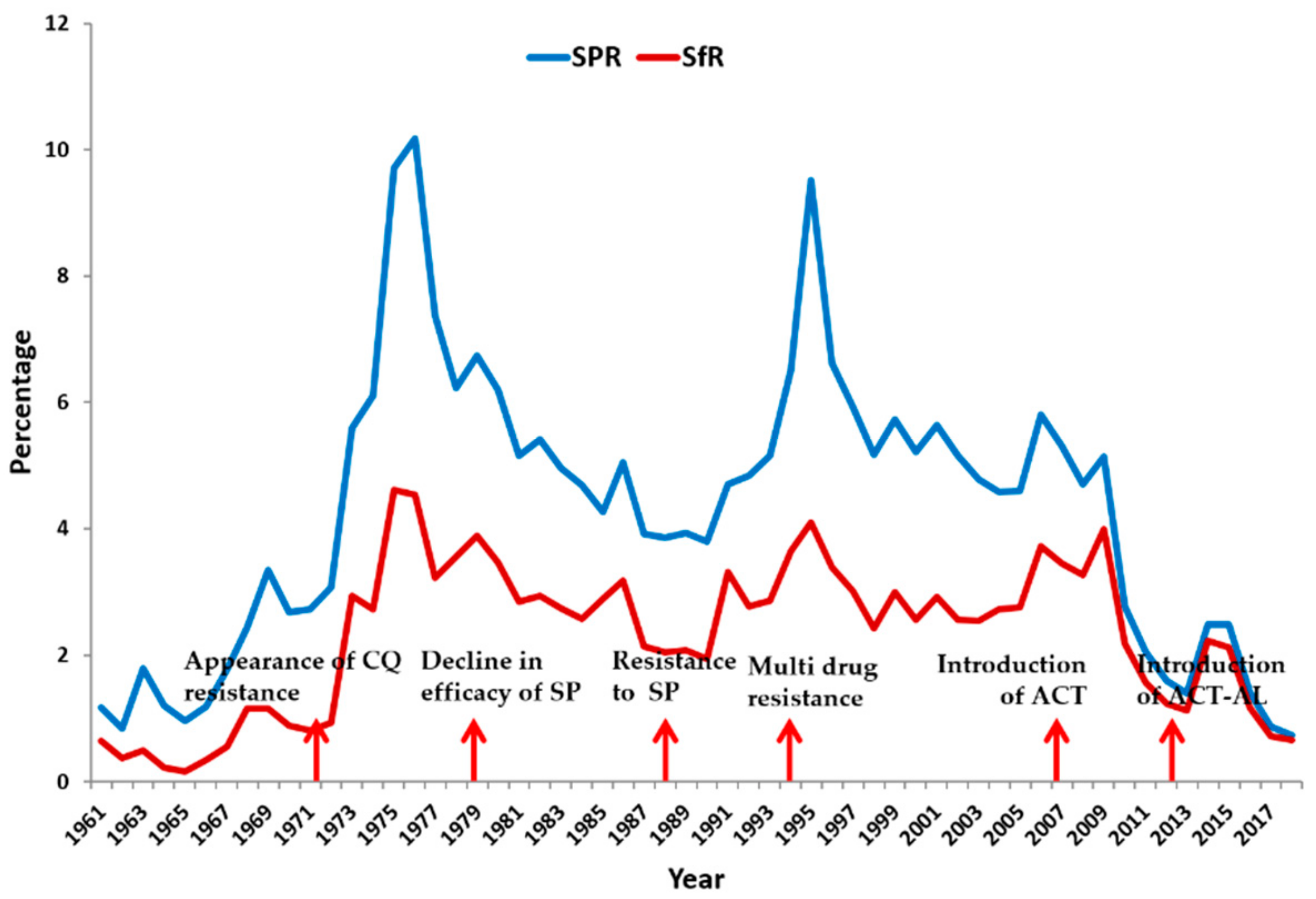
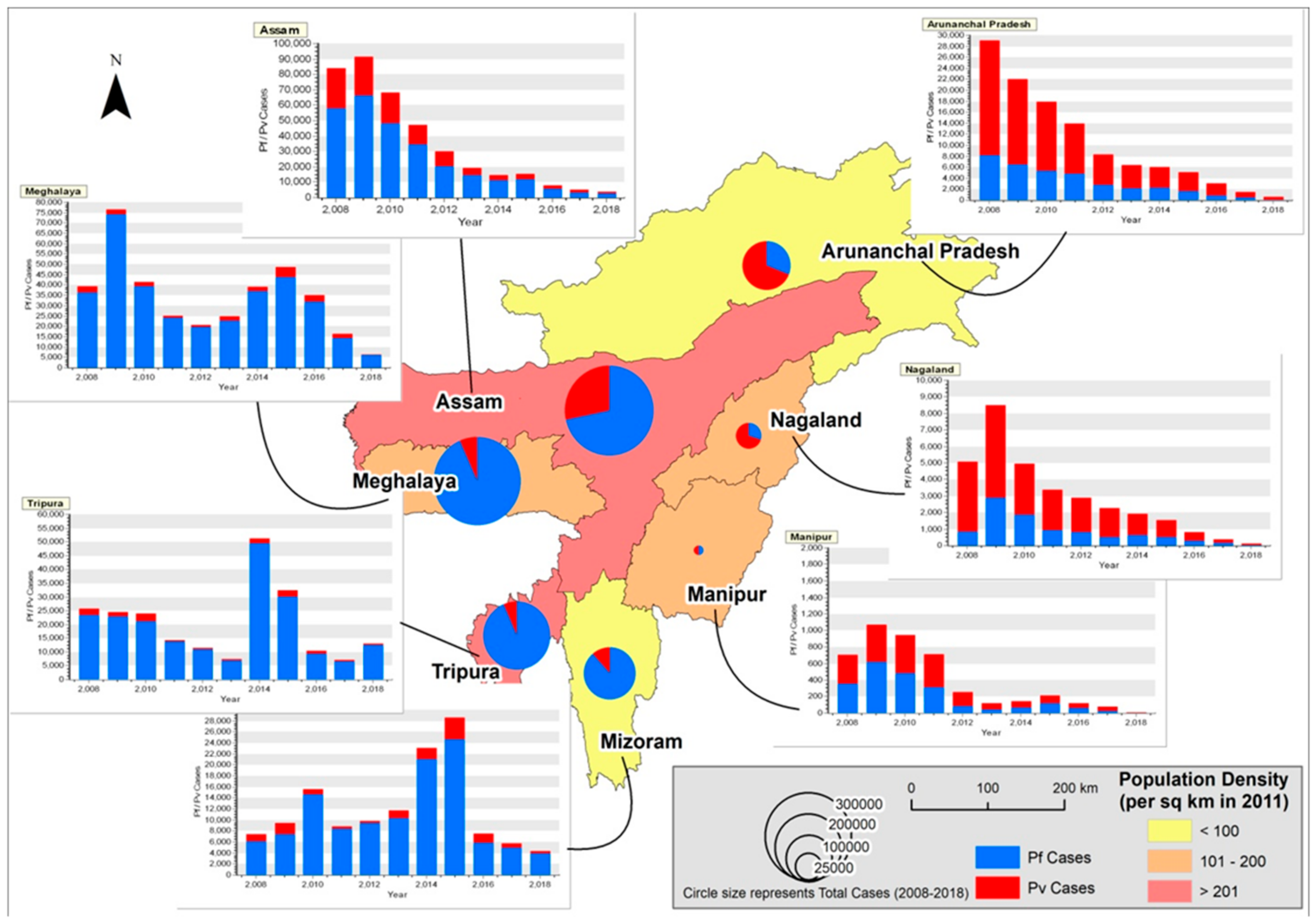
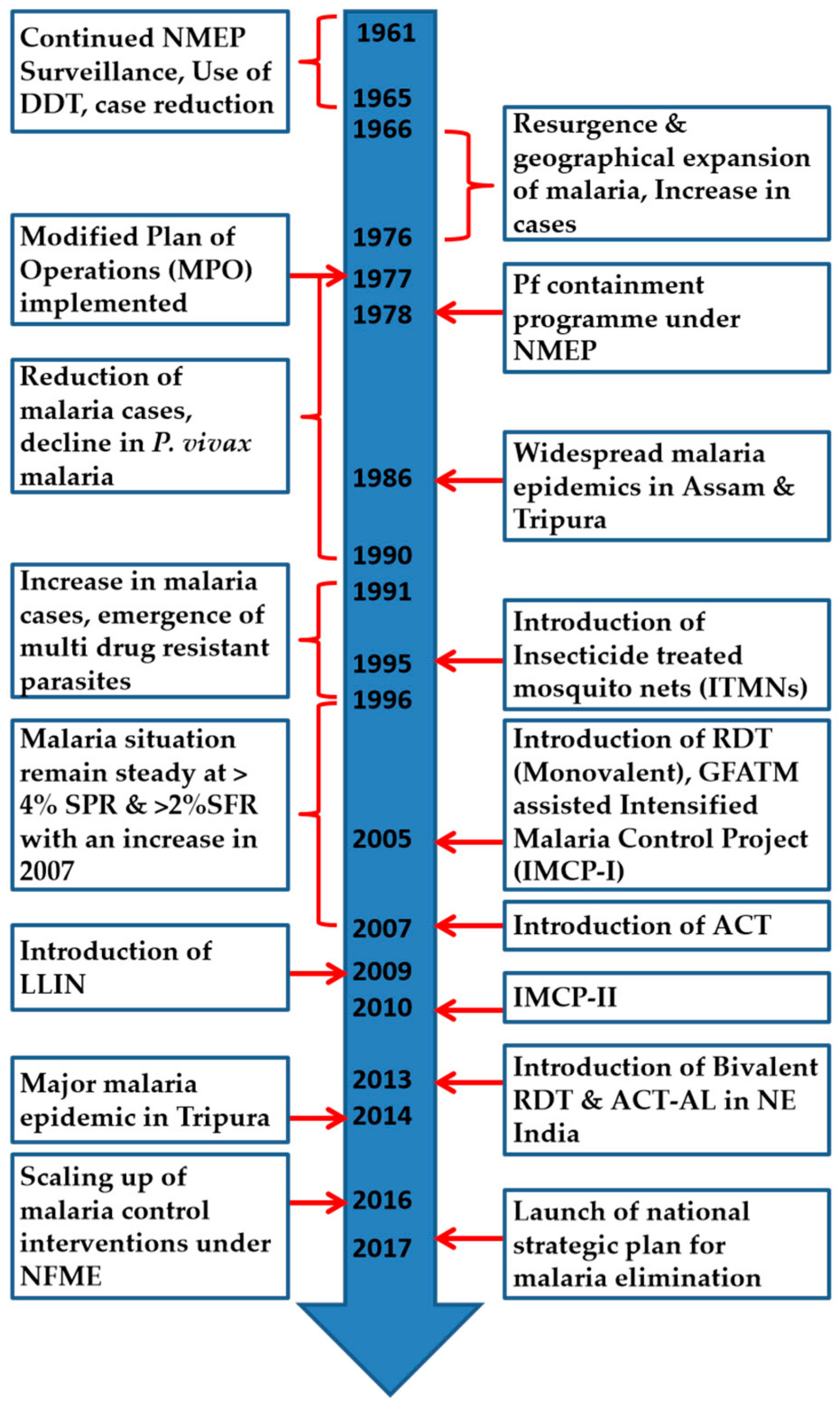
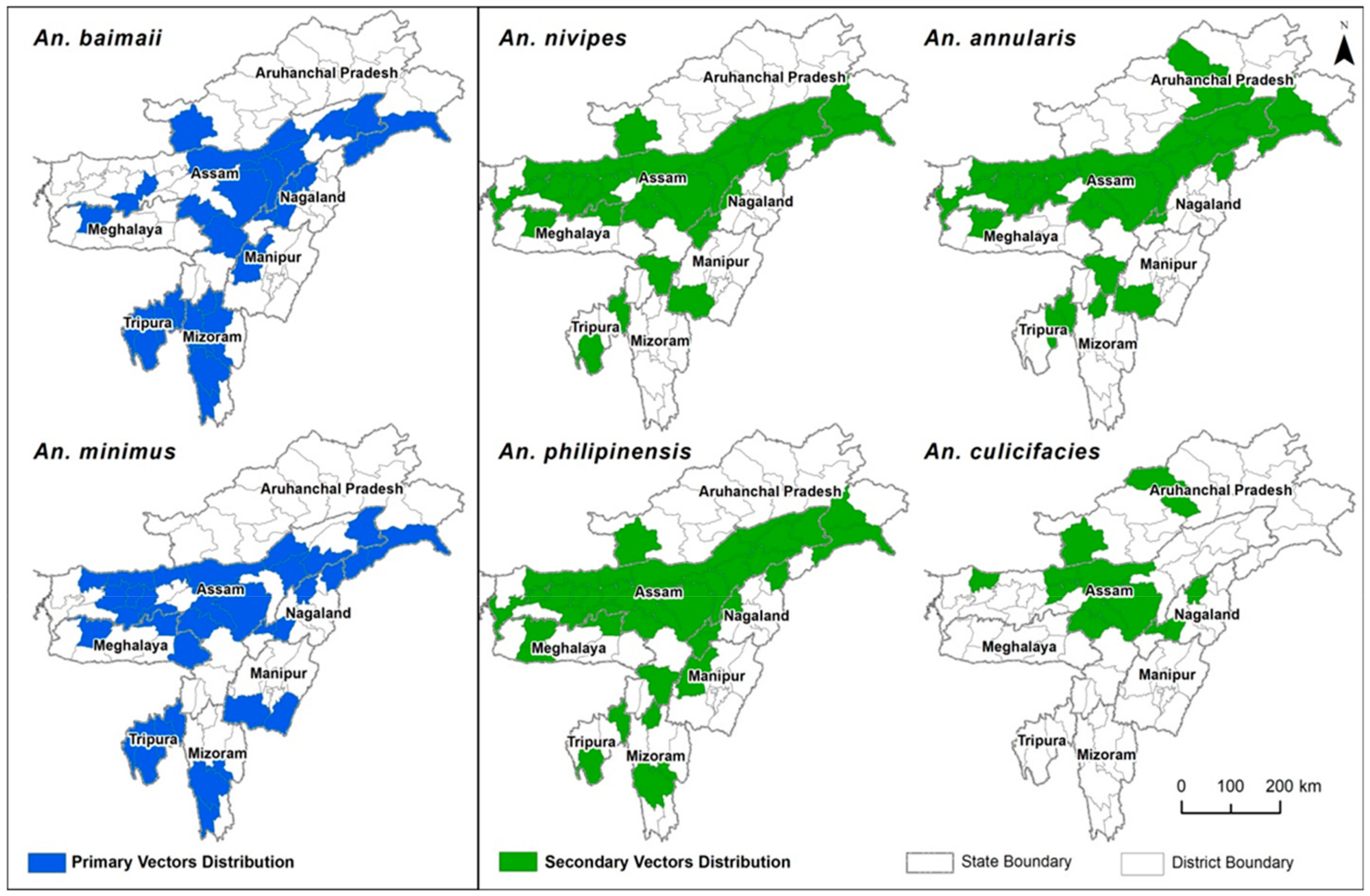
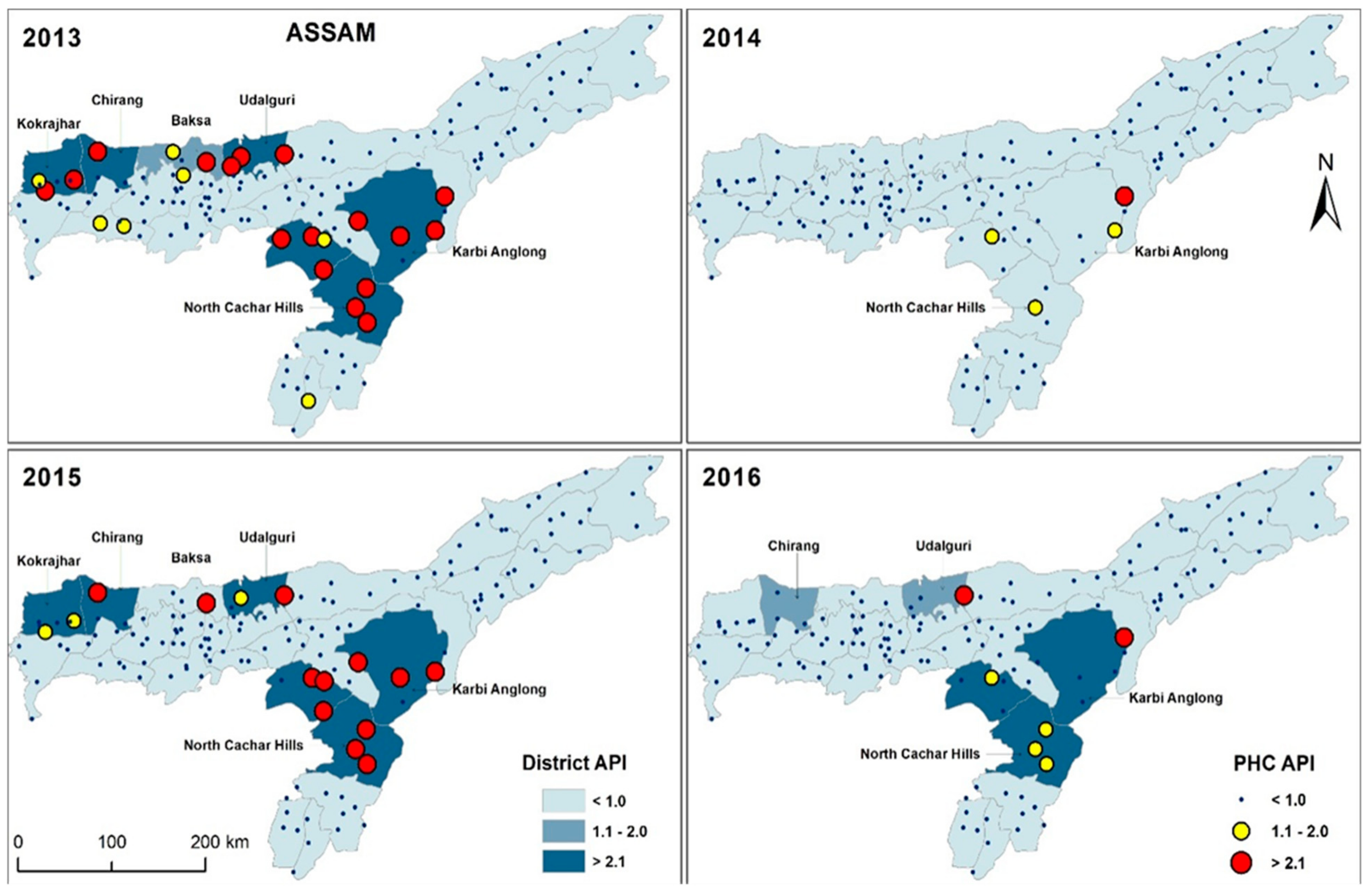
| NE States | Assam, Arunachal Pradesh, Mizoram, Tripura, Meghalaya, Nagaland and Manipur |
|---|---|
| Geographical Area | 255,128 Km2 (consists of hills, valleys and plains) |
| National proportion to land cover | 8% |
| Total Population | 45161611 (2011 census) with an average density of 159 persons/km2 |
| Climate | Tropical monsoon humid climate |
| Contribution to nation’s malaria cases | 15.2% (in 2018) |
| Major Plasmodium spp. | P. falciparum and P. vivax |
| Primary malaria vectors | An. baimaii and An. minimus |
| Secondary malaria vectors | An. annularis, An. phillipinensis/nivipes, An. culicifacies etc. |
| Treatment for malaria | P. falciparum—Age-specific artemisinin combination therapy (Artemether-lumefantrine) with primaquine @ 0.75 mg/kg body weight on day 2 P. vivax—chloroquine (25 mg/kg body weight divided over three days) and primaquine (0.25 mg/kg body weight daily for 14 days.) For mixed infections—Age-specific artemisinin combination therapy (Artemether-lumefantrine) for 3 days + primaquine 0.25 mg per kg body weight daily for 14 days. |
| States | Assam | Arunachal Pradesh | Meghalaya | Mizoram | Nagaland | Manipur | Tripura | ||||||||||||||
|---|---|---|---|---|---|---|---|---|---|---|---|---|---|---|---|---|---|---|---|---|---|
| Year | Number of Malaria Cases | Plasmodium falciparum | Plasmodium vivax | Number of Malaria Cases | Plasmodium falciparum | Plasmodium vivax | Number of Malaria Cases | Plasmodium falciparum | Plasmodium vivax | Number of Malaria Cases | Plasmodium falciparum | Plasmodium vivax | Number of Malaria Cases | Plasmodium falciparum | Plasmodium vivax | Number of Malaria Cases | Plasmodium falciparum | Plasmodium vivax | Number of Malaria Cases | Plasmodium falciparum | Plasmodium vivax |
| 2008 | 83,939 | 58,124 | 25,815 | 29,146 | 8219 | 20,927 | 39,616 | 36,301 | 3315 | 7361 | 6172 | 1189 | 5078 | 835 | 4243 | 708 | 356 | 352 | 25,894 | 23,588 | 2306 |
| 2009 | 91,413 | 66,557 | 24,856 | 22,066 | 6602 | 15,464 | 76,759 | 74,251 | 2508 | 9399 | 7387 | 2012 | 8489 | 2893 | 5596 | 1069 | 620 | 449 | 24,430 | 22,952 | 1478 |
| 2010 | 68,353 | 48,330 | 20,023 | 17,944 | 5412 | 12,532 | 41,642 | 39,374 | 2268 | 15,594 | 14,664 | 930 | 4959 | 1877 | 3082 | 947 | 487 | 460 | 23,939 | 21,254 | 2685 |
| 2011 | 47,397 | 34,707 | 12,690 | 13,950 | 4856 | 9094 | 25,143 | 24,018 | 1125 | 8861 | 8373 | 488 | 3363 | 950 | 2413 | 714 | 314 | 400 | 14,417 | 13,812 | 605 |
| 2012 | 29,999 | 20,579 | 9420 | 8368 | 2789 | 5579 | 20,834 | 19,805 | 1029 | 9883 | 9437 | 446 | 2891 | 821 | 2070 | 255 | 83 | 172 | 11,565 | 10,915 | 650 |
| 2013 | 19,542 | 14,969 | 4573 | 6398 | 2181 | 4217 | 24,727 | 22,885 | 1842 | 11,747 | 10,340 | 1407 | 2285 | 519 | 1766 | 120 | 42 | 78 | 7396 | 6998 | 398 |
| 2014 | 14,540 | 11,210 | 3330 | 6082 | 2338 | 3744 | 39,168 | 37,149 | 2019 | 23,145 | 21,083 | 2062 | 1936 | 647 | 1289 | 145 | 72 | 73 | 51,240 | 49,653 | 1587 |
| 2015 | 15,557 | 11,675 | 3882 | 5088 | 1714 | 3374 | 48,603 | 43,828 | 4775 | 28,593 | 24,602 | 3991 | 1527 | 532 | 995 | 216 | 119 | 97 | 32,525 | 30,074 | 2451 |
| 2016 | 7826 | 5686 | 2140 | 3128 | 895 | 2233 | 35,147 | 31,867 | 3280 | 7583 | 5907 | 1676 | 828 | 316 | 512 | 122 | 58 | 64 | 10,546 | 9545 | 1001 |
| 2017 | 5281 | 3494 | 1787 | 1546 | 488 | 1058 | 16,454 | 14,418 | 2036 | 5715 | 4974 | 741 | 394 | 188 | 206 | 80 | 22 | 58 | 7051 | 6571 | 480 |
| 2018 | 3816 | 2859 | 957 | 625 | 154 | 471 | 6394 | 6065 | 329 | 4296 | 3937 | 359 | 113 | 24 | 89 | 12 | 3 | 9 | 13,079 | 12,600 | 479 |
| State | Pf Cases | Pv Cases | Total Cases (2008–2018) | Density (2011) | Population (2011) | Average Cases/Year (2008–2018) | Average Cases to Population | Total Cases to Population |
|---|---|---|---|---|---|---|---|---|
| Arunachal Pradesh | 35,648 | 78,693 | 114,341 | 17 | 1,382,611 | 10,394.63 | 0.75% | 8.3% |
| Assam | 278,190 | 109,473 | 387,663 | 397 | 31,169,272 | 35,242.09 | 0.11% | 1.2% |
| Manipur | 2176 | 2212 | 4388 | 122 | 2,721,756 | 398.90 | 0.01% | 0.2% |
| Meghalaya | 349,961 | 24,526 | 374,487 | 132 | 2,964,007 | 34,044.27 | 1.15% | 12.6% |
| Mizoram | 116,876 | 15,301 | 132,177 | 52 | 1,091,014 | 12,016.09 | 1.10% | 12.1% |
| Nagaland | 9602 | 22,261 | 31,863 | 119 | 1,980,602 | 2896.63 | 0.15% | 1.6% |
| Tripura | 207,962 | 14,120 | 222,082 | 350 | 3,671,032 | 20,189.27 | 0.55% | 6.0% |
© 2019 by the authors. Licensee MDPI, Basel, Switzerland. This article is an open access article distributed under the terms and conditions of the Creative Commons Attribution (CC BY) license (http://creativecommons.org/licenses/by/4.0/).
Share and Cite
Sarma, D.K.; Mohapatra, P.K.; Bhattacharyya, D.R.; Chellappan, S.; Karuppusamy, B.; Barman, K.; Senthil Kumar, N.; Dash, A.P.; Prakash, A.; Balabaskaran Nina, P. Malaria in North-East India: Importance and Implications in the Era of Elimination. Microorganisms 2019, 7, 673. https://doi.org/10.3390/microorganisms7120673
Sarma DK, Mohapatra PK, Bhattacharyya DR, Chellappan S, Karuppusamy B, Barman K, Senthil Kumar N, Dash AP, Prakash A, Balabaskaran Nina P. Malaria in North-East India: Importance and Implications in the Era of Elimination. Microorganisms. 2019; 7(12):673. https://doi.org/10.3390/microorganisms7120673
Chicago/Turabian StyleSarma, Devojit Kumar, Pradumnya Kishore Mohapatra, Dibya Ranjan Bhattacharyya, Savitha Chellappan, Balasubramani Karuppusamy, Keshab Barman, Nachimuthu Senthil Kumar, Aditya Prasad Dash, Anil Prakash, and Praveen Balabaskaran Nina. 2019. "Malaria in North-East India: Importance and Implications in the Era of Elimination" Microorganisms 7, no. 12: 673. https://doi.org/10.3390/microorganisms7120673
APA StyleSarma, D. K., Mohapatra, P. K., Bhattacharyya, D. R., Chellappan, S., Karuppusamy, B., Barman, K., Senthil Kumar, N., Dash, A. P., Prakash, A., & Balabaskaran Nina, P. (2019). Malaria in North-East India: Importance and Implications in the Era of Elimination. Microorganisms, 7(12), 673. https://doi.org/10.3390/microorganisms7120673






